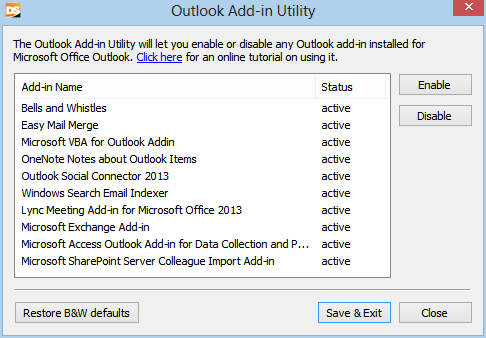

- #Manually remove outlook plugins how to#
- #Manually remove outlook plugins pdf#
- #Manually remove outlook plugins software#
- #Manually remove outlook plugins password#
For example, when you install Adobe’s Acrobat PDF reader, it installs an Outlook add-in that lets you make PDFs out of emails. They’re intended to make it easier for you to use a product. You may never use the add-ins, or even be aware that they’re there, but they aren’t (usually) malware or anything nasty.

#Manually remove outlook plugins software#
However, most add-ins are installed automatically when you install a piece of software on your computer. You can install add-ins yourself by opening Outlook and clicking Home > Get Add-ins, which will show you some of the add-ins available to you. What are Add-Ins?Īdd-ins are extra bits of functionality that software providers create to hook their application into Outlook.
#Manually remove outlook plugins how to#
Here’s how to disable them so you can tell if they’re the issue. If the Outlook client starts behaving oddly, one of the first things to do is see whether add-ins are causing the problem. Select the add-in to display additional information about the add-in in the right pane The add-in supplier is listed in the provider column.

For most add-ins, you can find the company that supplied the add-in by selecting File > Add-ins. If that doesn’t solve the issue, contact the company that supplied the add-in. If an Outlook detects a problem with an add-in, you can uninstall and reinstall the add-in. Outlook soft resiliency add-in notificationsįor some scenarios (or events), Outlook doesn’t disable the unhealthy add-in automatically, but takes a more softened approach where it shows the following notification and provides an option to disable in case you want to disable it yourself. If the unhealthy COM add-in is in Always Enabled List, it allows you to choose from one of the following optionsĭo not monitor the add-in for the next 7 daysĭo not monitor this add-in for the next 30 days In the case where the unhealthy COM add-in is automatically disabled by Outlook or disabled by you, the dialog box will give you an option to check ‘Always enable this add-in’.Ģ. You can also reach the dialog when you click on View Disabled Add-ins or View More Details from the notification that pops up.ġ. It will show the average delay time next to each unhealthy add-in.

Or, if the add-in is Always Enabled by the user, then Outlook displays the reason why it marked the add-in as unhealthy in the warning notification and seeks permission from you to disable it when you select View More Details Fixing Outlook unhealthy add-in notificationsĪll the unhealthy COM add-ins are listed under the dialog File -> Slow and Disabled COM Add-ins. When this happens, Outlook displays a warning in the notification bar When such issues arise, Outlook will perform one of two actions:ĭisable the add-in automatically. These problems could be due to latency of events such as switching between Outlook folders, arrival of new emails, opening Calendar items, etc. Since add-ins are separate programs, occasionally an Outlook COM add-in can encounter problems that slows down the rest of Outlook.
#Manually remove outlook plugins password#
For example, if you use a password management service or an online meeting service, including Skype, you may have an Outlook add-in assisting you. Outlook add-ins and COM add-ins are programs that run within Outlook and perform actions that Outlook doesn’t provide.


 0 kommentar(er)
0 kommentar(er)
